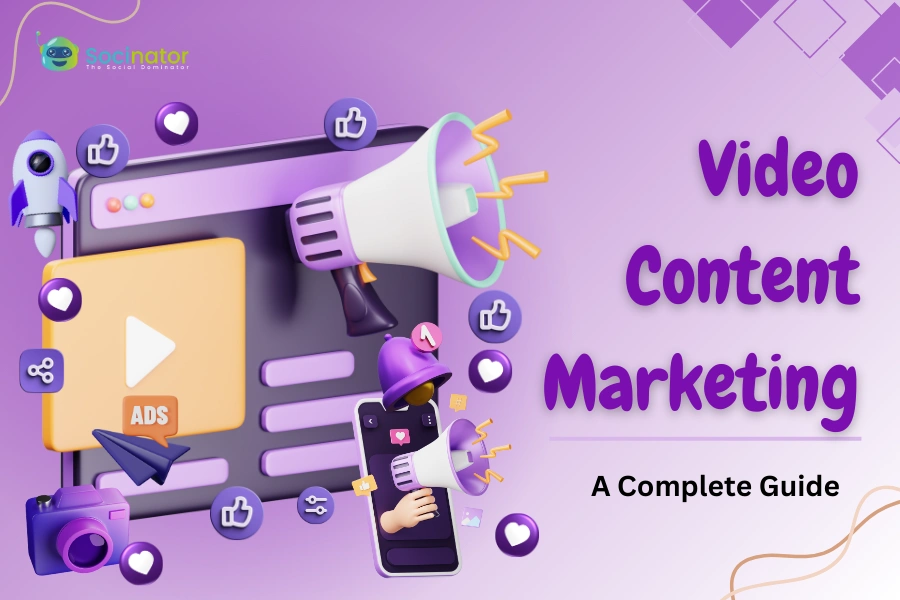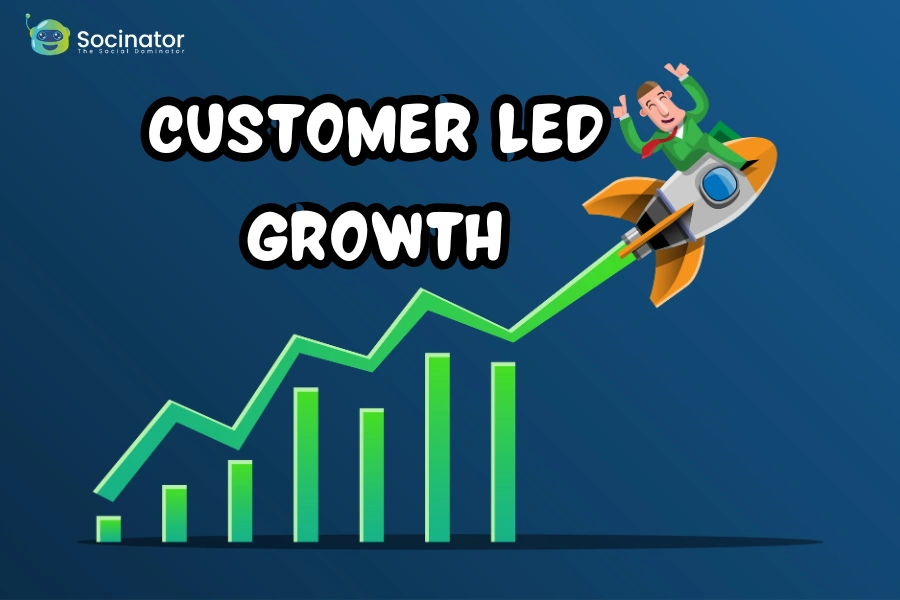Ready to boost your brand with video content marketing?
In today’s digital world, video is a game-changer for driving traffic, engaging customers, and enhancing your marketing strategy. Creating high-quality 4K videos is easier and more affordable than ever, even with a smartphone.
However, mastering video marketing involves more than just shooting footage- it requires effective strategy, the right equipment, and smart editing. This guide is your essential resource for content marketing through videos. We’ll show you how to create captivating videos, optimize them for search engines, and measure their impact.
Whether you’re experienced or new to video marketing, our tips will help you get the most out of your video content, from explainer videos and product demos to using a video interview platform for showcasing expert insights.
Let us begin by understanding what it is.
Hit ‘Play’ Button & Tune Into The Blog!
What Is Video Content Marketing?
Video content marketing involves using video as a strategic tool to promote and grow your business. It encompasses creating and sharing videos to attract, engage, and convert your target audience. Unlike traditional advertising, video marketing focuses on providing value through informative, entertaining, or inspiring content.
The goal is to build brand awareness, drive traffic, and foster customer loyalty by connecting with viewers dynamically. From explainer videos and product demos to customer testimonials and educational content, video marketing leverages the power of visual storytelling to capture attention and communicate your message effectively.
In short, it involves producing and sharing captivating videos to boost brand visibility and drive sales.
Why Is Video Content Marketing Important?
 As a business owner, you know that high-quality video content is key to reaching your audience. Content marketing through a video lets you tell your story in a visually engaging way, connecting customers with your products or services effortlessly. It’s a powerful tool to showcase what you offer and boost sales and brand awareness.
As a business owner, you know that high-quality video content is key to reaching your audience. Content marketing through a video lets you tell your story in a visually engaging way, connecting customers with your products or services effortlessly. It’s a powerful tool to showcase what you offer and boost sales and brand awareness.
Video marketing started gaining momentum in 2005 with YouTube. After Google bought YouTube in 2006, the platform added various ad options by 2009. The ease of creating videos and the rise of smartphones made watching videos simple and convenient. The pandemic also increased online video use by 215% in the U.S. Today, people spend an average of 17 hours a week watching videos online.
With video content marketing being so crucial, brands can’t afford to ignore it. So let’s learn about its benefits.
Benefits Of Video Content Marketing:
Boosts Social Sharing:
Video ranks as the second most popular content type on social media for boosting engagement. Platforms like YouTube have always centered around video content, while Instagram and Facebook have also started preferring video content.
Even platforms without native video uploads highlight the importance of live video marketing. Tweets on X see 10 times more engagement when they include video. This year, 68% of video marketers intend to leverage LinkedIn video. Nearly a billion videos are watched daily on Pinterest.
Enhances SEO and Increases Conversions And Sales:
Thirty-one percent of marketers use video content to improve SEO and boost engagement. Despite acquisition costs, 83% say video generates leads. Video enhances marketing, sales, and customer support throughout the customer journey, helping sales teams and using analytics to prioritize cold leads.
Appeals To Mobile Users:
 Mobile users significantly drive video consumption. Studies reveal that 77% of respondents use smartphones or tablets to watch online videos. Additionally, Facebook reports that people are 1.5 times more likely to watch videos daily on a smartphone than on a computer.
Mobile users significantly drive video consumption. Studies reveal that 77% of respondents use smartphones or tablets to watch online videos. Additionally, Facebook reports that people are 1.5 times more likely to watch videos daily on a smartphone than on a computer.
We’ve all experienced it! Relaxing in bed and scrolling through videos is both effortless and enjoyable.
Improves Conversion Rates:
Video content marketing boosts conversion rates by engaging viewers better than text or images. Videos demonstrate products, explain services, and tell stories that build trust and emotional connections.
They keep visitors on your site longer, increasing the likelihood of taking action. Videos also address common customer questions, reducing barriers and making the decision-making process smoother for potential buyers.
Boosts Click-Through Rates:
Video marketing boosts click-through rates (CTR) by capturing attention and engaging viewers better than static content. Videos stand out in crowded feeds, quickly conveying messages and prompting action.
Effective calls to action within videos can drive clicks to websites, landing pages, or product pages, increasing engagement and marketing success.
Let us now learn how you can craft a perfect video marketing strategy.
How To Craft A Video Content Marketing Strategy
Crafting a successful video content marketing strategy involves several key steps. They are:
Have Definite Goals:
Start by clearly identifying what you want to achieve with your video marketing efforts. Are you looking to increase brand awareness so more people recognize and remember your brand? Do you want to generate leads by encouraging potential customers to provide their contact information? Or is your goal to educate your customers about your products or services, helping them understand how to use them effectively? Knowing your goals will guide your content creation and help measure your success.
Understand Your Audience:
 Take the time to research and get to know your target audience. Find out what they like, what interests them, and how they behave online. Are they young or older? What are their hobbies and favorite activities? What problems do they have that you can solve?
Take the time to research and get to know your target audience. Find out what they like, what interests them, and how they behave online. Are they young or older? What are their hobbies and favorite activities? What problems do they have that you can solve?
Understanding these details will help you create a video content marketing strategy that speaks directly to them. When you know what your audience cares about, you can make videos that grab their attention, keep them engaged, and make them more likely to take action, like sharing your video or buying your product.
Plan Your Content:
First, decide what kinds of videos you’ll make. For example, you might create explainer videos to show how your product works, product demos to highlight features, or testimonials where happy customers share their experiences. Next, choose the video content marketing platform where you’ll share these videos.
Popular options include YouTube for long videos, Instagram for short and engaging clips, and LinkedIn for professional content. Think about where your audience spends their time online. By planning your content and selecting the right platforms, you can ensure your videos reach and resonate with your target audience.
Create a Content Calendar:
Start by setting a schedule for when to make and release your videos. A content calendar can help you plan everything in advance so that you stay organized and on track. Write down the dates for brainstorming ideas, filming, editing, and posting each video.
This way, you can see what needs to be done and when. A consistent posting schedule keeps your audience engaged and looking forward to your content. A content calendar can help you avoid last-minute rushes and ensure you always have fresh videos ready to share with your viewers.
You can also use a social media automation tool like Socinator to schedule your videos and improve your video content marketing strategies.
Socinator- Automate Your Social Media Journey And Ease Your Video Marketing Efforts
 Socinator is an easy-to-use automation tool designed for busy marketers to handle social media posting on platforms like Facebook, Instagram, Twitter, LinkedIn, Quora, YouTube, Pinterest, and Reddit.
Socinator is an easy-to-use automation tool designed for busy marketers to handle social media posting on platforms like Facebook, Instagram, Twitter, LinkedIn, Quora, YouTube, Pinterest, and Reddit.
It helps marketers manage and grow their social media accounts safely and efficiently.
It saves time by combining all your social media accounts into one login, offering a seamless user experience, and providing automation options for all major platforms.
With Socinator, you can schedule and automatically publish posts across multiple social media networks, including YouTube, Instagram, Twitter, Facebook and more.
Here are some of the benefits of using Socinator:
Activity Statistics & Reports:
Easily track and view all data and stats for your account activities. It helps you analyze and improve your marketing strategies. Get detailed insights about your YouTube channel’s performance using Socinator’s activity and statistics feature.
Auto Subscribe:
Automatically create subscription links for your YouTube channel to grow your subscriber base quickly.
Auto Like:
You can increase the popularity of your content by using multiple accounts and automatically like your content through Socinator.
Auto Comment on Videos:
Post and reply to comments in bulk using multiple accounts and spinning text mode.
Efficient Account Management:
Manage multiple Social media accounts and channels easily with this powerful software.
Like Comments:
If you can’t reply to every comment from your followers, a simple like can show your appreciation.
Now that we know how beneficial this tool is in your video marketing journey- let us learn about the other tips on crafting a social media video marketing strategy for your video content marketing.
Select The Best Platform To Share Your Video:
 Before creating your video, decide where you’ll share it. YouTube SEO is now as crucial as website SEO, so consider what viewers on that platform seek. Also, consider factors like average view time, size and sound restrictions, community engagement, budget, and promotion strategies.
Before creating your video, decide where you’ll share it. YouTube SEO is now as crucial as website SEO, so consider what viewers on that platform seek. Also, consider factors like average view time, size and sound restrictions, community engagement, budget, and promotion strategies.
Remember, videos don’t promote themselves. Some platforms offer built-in promotion tools, while others require additional effort to attract viewers. We recommend evaluating your marketing resources and choosing the platform that best suits your needs in video marketing.
Also Read:
How To Use Live Video Marketing To Grow Your Business
Top 5 Goals To Accomplish Using Social Media Video Marketing
Earn From Video Ads In 2022 | Video Marketing Strategy
Promote Your Videos:
Reach a wider audience by sharing your videos on social media, email marketing, and other platforms. For efficient video content marketing, you can use Facebook, Twitter, Instagram, and LinkedIn to post your videos and send them to your email subscribers.
Encourage viewers to like, share, and comment to boost visibility and engagement. The more people interact with your videos, the more they will be seen by others. It helps spread your message further and attract more viewers to your content.
Analyze Performance:
Use analytics tools to monitor important metrics like how many people watch your videos, how they interact with them, and how often they take desired actions, such as signing up or purchasing. These tools can show you which videos are performing well and which aren’t.
You can understand what’s effective and needs improvement. It helps you refine your strategy, make better content, and achieve better results in your video marketing efforts.
Engage with Your Audience:
 Take the time to reply to comments on your videos and interact with viewers. Show appreciation for their feedback and answer their questions. It helps build a strong connection with your audience and creates a sense of community around your content.
Take the time to reply to comments on your videos and interact with viewers. Show appreciation for their feedback and answer their questions. It helps build a strong connection with your audience and creates a sense of community around your content.
Engaging with your viewers makes them feel valued and encourages them to stay involved and return for more. Building these relationships can lead to increased loyalty and a more supportive audience, thus impacting your video content marketing efforts positively.
Refine And Improve Your Performance:
Take the information you gather from analyzing your video performance and use it to make changes. Look at what’s working well and what isn’t. Use these insights to tweak your strategy, update your content, and better align with your goals.
It means making adjustments based on what your audience likes and what helps achieve your objectives. You can create more effective videos and improve your results over time by continuously refining your approach.
Let us now learn about the different marketing videos you can take inspiration from based on your needs.
Types Of Marketing Videos:
Before creating your videos, determine the type of video you want to craft. Review this list to explore your available options and choose the best fit for your needs.
Demo Videos:
Demonstration videos are a form of video content marketing that illustrates how your product operates. You could offer a guided tour of your software or a hands-on demonstration of a physical product, demonstrating its performance in real-life situations.
Brand Videos:
Brand videos are often produced in a broader advertising campaign, highlighting your company’s vision, mission, or offerings. They are designed to enhance brand awareness, capture the interest of your target audience, and create a connection with them. These videos aim to build curiosity and attract potential customers to your brand.
Event Videos:
 If your business is organizing a conference, panel discussion, fundraiser, or similar event, create a highlight reel or share engaging interviews and presentations from your event. It can positively assist your video content marketing effort as these videos capture key moments and valuable insights, allowing you to showcase the event’s impact and reach a broader audience.
If your business is organizing a conference, panel discussion, fundraiser, or similar event, create a highlight reel or share engaging interviews and presentations from your event. It can positively assist your video content marketing effort as these videos capture key moments and valuable insights, allowing you to showcase the event’s impact and reach a broader audience.
Expert Interviews:
An effective way to establish trust and credibility with your audience is through interviews with internal experts or industry thought leaders. Identify key influencers in your field and present these insightful conversations to your viewers. This approach helps position your brand as an authority and provides valuable perspectives to your target audience.
Don’t hesitate to dive into specific details in your interviews — your audience will appreciate the depth of your effort and benefit from the valuable insights you provide.
Educational or How-To Videos:
Instructional video ads are a great way to teach your audience new skills or knowledge. These videos not only provide valuable information but also help viewers gain a better understanding of your business and its solutions. They can serve as foundational resources for your audience and be utilized by your sales and service teams to assist customers effectively.
Explainer Videos:
Explainer videos are a form of video content marketing designed to clarify why your product or service is essential. Often, these videos depict a fictional scenario involving your ideal customer, who faces a challenge and resolves it using your solution. This approach helps viewers relate to the problem and understand how your offering can make a difference.
Case Study and Customer Testimonial Videos:
Prospective customers want assurance that your product can address their specific issues. Showcasing case study videos with satisfied, loyal customers is one of the most effective ways to demonstrate this. Feature these customers as they discuss their problems and how your company provided the solution, serving as powerful endorsements of your product.
Personalized Messages:
Using video can add a personal touch to your communications via email or text. These videos create a unique and engaging experience for your prospects, helping to advance them further along the purchasing process.
Final Words:
Video content marketing is a powerful and versatile tool for promoting products, services, or brands and engaging potential customers. It helps build brand awareness and loyalty while driving meaningful results.
Although video marketing can seem daunting initially, with practice and patience, you can create high-quality, unique content for your brand. By understanding your goals, knowing your audience, and selecting the appropriate video types and platforms, you can produce compelling content that stands out.
Utilize YouTube marketing software such as Socinator to promote your videos, analyze their performance, and continuously improve based on feedback to achieve your business goals.
Video Content Marketing FAQs
Is A Video Marketing Campaign Costly?
The cost of a video content marketing campaign can vary, but generally, it doesn’t have to be expensive. The expense largely depends on whether you hire a video marketing agency or produce videos in-house. Numerous online tools and apps are available that are either free or affordable, which can significantly aid in your video creation process.
What Types Of Videos Captivate An Audience?
The answer depends on your brand and the purpose of the video. Generally, news and comedy videos attract many viewers, but that’s a broad idea. The main thing to focus on is making content that keeps people interested. Whether they’re watching for fun or to learn something, it’s vital to keep it engaging. No one likes to watch boring content!
What Is The Ideal Length For A Content Marketing Video?
Here are some general recommendations for the ideal length of different types of video content marketing videos:
- Explainer Videos: 1-2 minutes.
- Product Demos: 2-3 minutes.
- Testimonials: 1-2 minutes.
- Live Streams: Typically more engaging if kept under 30 minutes.
- Brand Videos: 2-3 minutes.
- How-to Videos: 2-5 minutes, based on the topic’s complexity.
- Animated Videos: 1-2 minutes.
Align your video’s length with your goals and your audience’s attention span. Keep it concise, clear, and impactful. Consider platform requirements and audience preferences when deciding the optimal duration.






